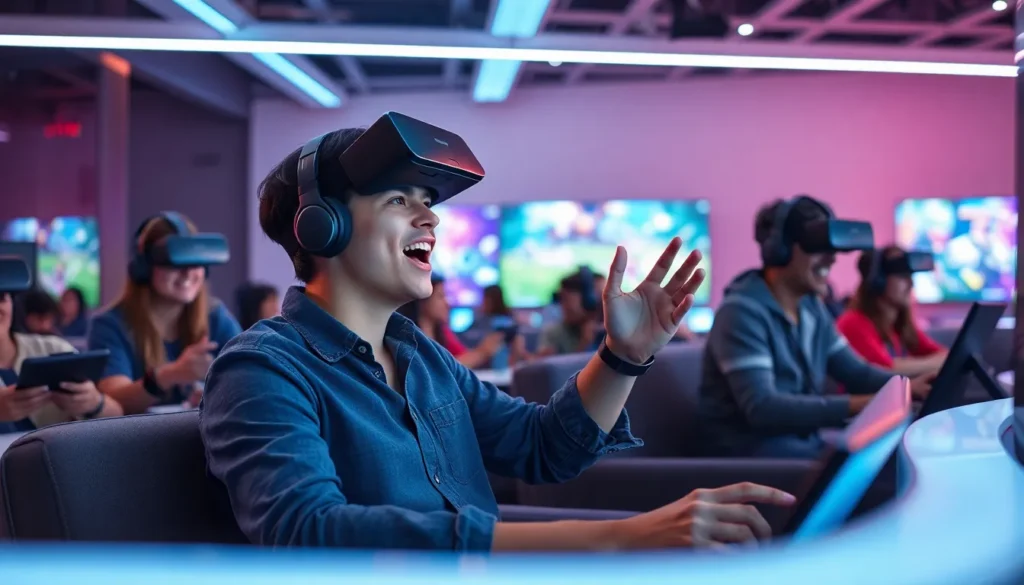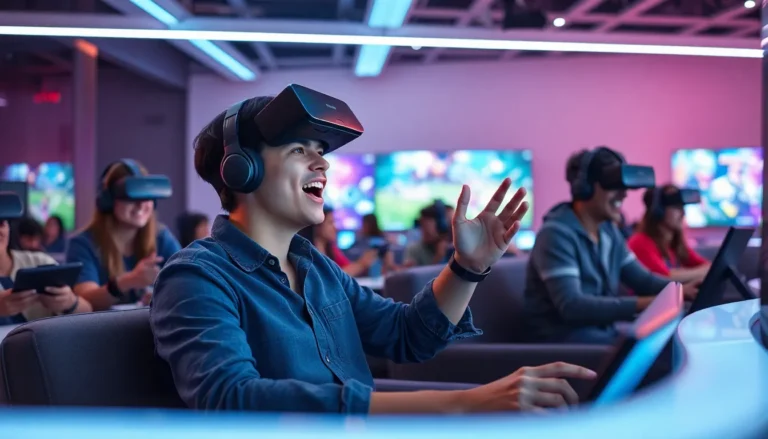Table of Contents
ToggleThe gaming industry is in a constant state of evolution, driven by technological advancements and creative ingenuity. From virtual reality to cloud gaming, innovations are reshaping how players experience their favorite titles. These developments not only enhance gameplay but also broaden access to gaming, making it more inclusive than ever.
As developers push the boundaries of what’s possible, gamers are treated to immersive worlds and interactive narratives that were once the stuff of dreams. This article explores the latest innovations in gaming, highlighting trends that are setting the stage for the future. Whether it’s through cutting-edge graphics or AI-driven gameplay, the landscape of gaming is transforming rapidly, and there’s no sign of slowing down.
Overview of Innovations in Gaming
Innovations in gaming continuously reshape the industry, enhancing player experiences and expanding opportunities. Key advancements include:
- Virtual Reality (VR): VR immerses players in digital environments, creating realistic experiences. Headsets like the Oculus Rift and HTC Vive provide unmatched engagement through innovative control systems and enhanced graphics.
- Augmented Reality (AR): AR technology integrates digital elements into the real world, allowing gamers to interact with both environments. Games like Pokémon GO demonstrate how AR fosters community engagement and redefines gameplay.
- Cloud Gaming: Cloud gaming eliminates the need for high-end hardware, as players access games via the internet. Services such as Google Stadia and NVIDIA GeForce Now provide seamless gameplay across various devices, enhancing accessibility.
- Artificial Intelligence (AI): AI enhances gameplay through adaptive learning and dynamic environments. Games utilize AI for opponents’ behavior, improving game difficulty and realism, as seen in titles like The Last of Us Part II.
- Cross-Platform Play: Cross-platform functionality lets players from different devices compete together, increasing player bases and fostering inclusivity. Popular titles like Fortnite and Rocket League exemplify the benefits of cross-platform gaming.
- Enhanced Graphics and Realism: Advances in graphics technology, such as ray tracing and high refresh rates, improve visual fidelity. Engines like Unreal Engine 5 enable developers to create breathtaking visuals that heighten immersion.
Innovations in gaming push boundaries, transforming how players engage with digital worlds. The continuous evolution of technology and creativity signals exciting times for gamers and developers alike.
Technological Advancements

Technological advancements significantly shape the gaming industry, providing players with immersive experiences and transforming gameplay dynamics. Key innovations, such as virtual reality (VR) and augmented reality (AR), are at the forefront of this evolution.
Virtual Reality
Virtual reality creates fully immersive environments, allowing players to engage with digital worlds in unprecedented ways. Headsets like the Oculus Quest 2 and PlayStation VR deliver enhanced sensory experiences, incorporating 360-degree visuals and spatial audio. VR titles, including Half-Life: Alyx and Beat Saber, exemplify this technology by providing interactive gameplay that feels tangible and responsive. Players can physically move within their environments, increasing immersion and engagement levels.
Augmented Reality
Augmented reality blends digital elements with the real world, expanding gameplay beyond traditional screens. Games like Pokémon GO and Harry Potter: Wizards Unite encourage players to explore their surroundings, fostering social interaction and community involvement. AR technology uses mobile devices’ cameras and sensors to overlay virtual objects onto real-life settings, creating a new layer of gameplay. The innovation not only enhances entertainment but also promotes physical activity, as players must walk and explore to progress in these interactive experiences.
Game Design Innovations
Game design innovations significantly enhance player experiences. They introduce new methods for creating dynamic worlds and storytelling techniques that keep players engaged.
Procedural Generation
Procedural generation transforms game design by using algorithms to create game content dynamically. This method allows developers to generate expansive environments, intricate levels, and diverse character models without manual input. Games like “No Man’s Sky” illustrate this approach, offering billions of procedurally generated planets for exploration. This technique provides unique gameplay experiences, as no two encounters are identical. Additionally, procedural generation improves replayability and reduces development time by automating content creation.
Narrative Techniques
Innovative narrative techniques reshape storytelling in games. Branching narratives invite players to make choices that alter the course of the story. Titles like “Detroit: Become Human” leverage this feature, presenting multiple endings based on player decisions. Furthermore, non-linear storytelling allows players to explore narratives at their own pace, as seen in “The Witcher 3: Wild Hunt.” Interactive dialogues enhance immersion by placing the player in pivotal roles. These narrative advancements make stories more engaging and personal, offering deeper emotional connections between players and characters.
Player Engagement Strategies
Player engagement in gaming has evolved, utilizing innovative strategies to enhance experiences and foster player loyalty. Gamification and community building have emerged as key elements in this landscape.
Gamification
Gamification integrates game elements into non-game contexts to enhance engagement. Techniques include reward systems, challenges, and leaderboards. These elements motivate players to achieve goals and sustain interest. For example, many games utilize experience points (XP) and achievement unlocks, encouraging players to explore and complete various objectives. Implementing daily challenges and events provides players with ongoing incentives, creating a sense of accomplishment. This strategy not only enriches gameplay but also fosters a competitive spirit among players.
Community Building
Community building fosters connections among players, enhancing overall engagement. Game developers create forums, social media groups, and in-game features to encourage interaction. These platforms serve as spaces for players to share experiences, provide feedback, and collaborate on strategies. Incorporating cooperative gameplay modes and clan systems strengthens social bonds in-game, allowing players to work together toward common goals. Events like tournaments and live-streamed games promote community involvement, showcasing player skills while creating shared experiences. Successful community building enhances player loyalty and contributes to a vibrant gaming ecosystem.
Future Trends in Gaming
Advancements in gaming technologies continue to shape the future of the industry. Five major trends emerge, each contributing to the next wave of innovation and player engagement.
- Enhanced VR and AR Experiences: Developers focus on improving VR and AR technologies, creating seamless user experiences. Upcoming headsets promise higher resolutions and better motion tracking, which allow for more immersive gameplay. Titles such as Horizon Call of the Mountain exemplify this evolution.
- AI Integration: AI technology continues to evolve, providing smarter NPCs and adaptive difficulty settings. Future games will incorporate AI-driven content generation for dynamic storytelling, reducing redundancy and enhancing replayability. Titles utilizing these advancements include Watch Dogs: Legion.
- Blockchain and NFTs: The integration of blockchain technology and Non-Fungible Tokens (NFTs) modifies game ownership and in-game economies. Blockchain ensures transparent transactions while enabling players to trade unique digital assets across platforms, as seen in games like Axie Infinity.
- Cross-Platform and Cloud Gaming Growth: Cross-platform play becomes the standard, enabling seamless gameplay between various devices. Cloud gaming platforms such as NVIDIA GeForce NOW and Amazon Luna offer gamers access to high-quality titles without the need for costly hardware, extending reach to a broader audience.
- Focus on Inclusivity and Accessibility: The gaming industry aims to create more inclusive environments. Upcoming titles will prioritize accessibility features, allowing gamers with disabilities to engage with content fully. Innovations include customizable controls and audiovisual aids in games like The Last of Us Part II.
These trends indicate a shift toward a more immersive, connected, and inclusive gaming ecosystem, fostering engagement and creativity while maintaining a focus on player experience and satisfaction.
The gaming industry stands at the forefront of innovation with advancements that continuously reshape player experiences. As technologies like VR and AI evolve, they create deeper connections between gamers and the virtual worlds they explore. The rise of cloud gaming and cross-platform play ensures that accessibility becomes a priority, inviting a diverse audience to join the gaming community.
With a focus on inclusivity and engaging narratives, developers are pushing boundaries and fostering creativity. This vibrant ecosystem not only enhances entertainment but also builds lasting relationships among players. As the future unfolds, the gaming landscape promises to be more immersive, connected, and engaging than ever before, paving the way for exciting new adventures.







